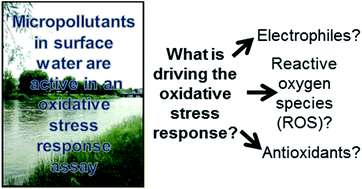当前位置:
X-MOL 学术
›
Environ. Sci.: Processes Impacts
›
论文详情
Our official English website, www.x-mol.net, welcomes your
feedback! (Note: you will need to create a separate account there.)
Exploring the oxidative stress response mechanism triggered by environmental water samples†
Environmental Science: Processes & Impacts ( IF 4.3 ) Pub Date : 2016-12-15 00:00:00 , DOI: 10.1039/c6em00541a Peta A. Neale 1, 2, 3, 4, 5 , Maud E. S. Achard 1, 2, 3, 4, 5 , Beate I. Escher 5, 6, 7, 8, 9 , Frederic D. L. Leusch 1, 2, 3, 4, 5
Environmental Science: Processes & Impacts ( IF 4.3 ) Pub Date : 2016-12-15 00:00:00 , DOI: 10.1039/c6em00541a Peta A. Neale 1, 2, 3, 4, 5 , Maud E. S. Achard 1, 2, 3, 4, 5 , Beate I. Escher 5, 6, 7, 8, 9 , Frederic D. L. Leusch 1, 2, 3, 4, 5
Affiliation

|
Environmental waters can contain a wide range of micropollutants. Bioanalytical test batteries using assays indicative of different stages of cellular toxicity pathways, such as adaptive stress responses, have been applied to a range of water samples. Oxidative stress response assays have proven to be sensitive tools, but the mechanism by which water samples are inducing the oxidative stress response remains unclear because both electrophiles and reactive oxygen species (ROS) may activate the Nrf2-antioxidant response element (ARE) pathway. The current study aimed to explore the underlying mechanisms of the oxidative stress response triggered by exposure to surface water extracts previously shown to be active in the ARE GeneBLAzer oxidative stress response assay. ROS formation and changes in glutathione (GSH) concentration were assessed in human liver cells exposed to water extracts from a large river in addition to individual chemicals that were detected in these water extracts and reported to be active in the ARE GeneBLAzer assay in a previous study. Many of the surface water samples induced ROS formation and decreased the GSH to glutathione disulfide (GSSG) ratio, suggesting that the formation of ROS is an important mechanism. However, some of the most responsive samples in the ARE GeneBLAzer assay, as well as the individual chemicals, did not have a significant effect on either ROS formation or the GSH/GSSG ratio, suggesting a different mechanism. Antioxidants can also induce the Nrf2-ARE pathway and the ARE GeneBLAzer assay may also detect compounds that activate ARE by Nrf2-independent mechanisms, thus further research is required to characterise active chemicals in oxidative stress response assays. However, these tests are still useful for quantifying the integrated cellular response to multiple molecular initiating events and can be used complementary to assays indicative of specific effects, such as receptor-mediated assays.
中文翻译:

探索环境水样触发的氧化应激反应机制†
环境水可能包含多种微量污染物。使用表明细胞毒性途径不同阶段(例如适应性应激反应)的测定法进行的生物分析测试电池已应用于一系列水样。氧化应激反应测定已被证明是灵敏的工具,但是水样品诱导氧化应激反应的机制尚不清楚,因为亲电子试剂和活性氧(ROS)均可激活Nrf2-抗氧化反应元件(ARE)途径。当前的研究旨在探讨由暴露于地表水提取物中而触发的氧化应激反应的潜在机制,该机制先前在ARE GeneBLAzer氧化应激反应测定中显示出活性。除了从大型水域提取物中检测到的单独化学物质外,还评估了暴露于大河水提取物中的人肝细胞中ROS的形成和谷胱甘肽(GSH)浓度的变化,该化学物质在以前的研究中据报道在ARE GeneBLAzer分析中具有活性。许多地表水样品诱导了ROS的形成,并降低了GSH与谷胱甘肽二硫化物(GSSG)的比率,这表明ROS的形成是重要的机制。但是,ARE GeneBLAzer分析中的某些反应最灵敏的样品以及单独的化学物质对ROS的形成或GSH / GSSG的比例均无显着影响,提示其机理不同。抗氧化剂也可以诱导Nrf2-ARE途径,并且ARE GeneBLAzer分析还可以检测通过非Nrf2依赖性机制激活ARE的化合物,因此,需要进一步的研究来表征氧化应激反应测定中的活性化学品。但是,这些测试仍可用于量化对多种分子引发事件的整合细胞反应,并可与指示特定作用的测定(例如受体介导的测定)互补使用。
更新日期:2016-12-15
中文翻译:

探索环境水样触发的氧化应激反应机制†
环境水可能包含多种微量污染物。使用表明细胞毒性途径不同阶段(例如适应性应激反应)的测定法进行的生物分析测试电池已应用于一系列水样。氧化应激反应测定已被证明是灵敏的工具,但是水样品诱导氧化应激反应的机制尚不清楚,因为亲电子试剂和活性氧(ROS)均可激活Nrf2-抗氧化反应元件(ARE)途径。当前的研究旨在探讨由暴露于地表水提取物中而触发的氧化应激反应的潜在机制,该机制先前在ARE GeneBLAzer氧化应激反应测定中显示出活性。除了从大型水域提取物中检测到的单独化学物质外,还评估了暴露于大河水提取物中的人肝细胞中ROS的形成和谷胱甘肽(GSH)浓度的变化,该化学物质在以前的研究中据报道在ARE GeneBLAzer分析中具有活性。许多地表水样品诱导了ROS的形成,并降低了GSH与谷胱甘肽二硫化物(GSSG)的比率,这表明ROS的形成是重要的机制。但是,ARE GeneBLAzer分析中的某些反应最灵敏的样品以及单独的化学物质对ROS的形成或GSH / GSSG的比例均无显着影响,提示其机理不同。抗氧化剂也可以诱导Nrf2-ARE途径,并且ARE GeneBLAzer分析还可以检测通过非Nrf2依赖性机制激活ARE的化合物,因此,需要进一步的研究来表征氧化应激反应测定中的活性化学品。但是,这些测试仍可用于量化对多种分子引发事件的整合细胞反应,并可与指示特定作用的测定(例如受体介导的测定)互补使用。











































 京公网安备 11010802027423号
京公网安备 11010802027423号